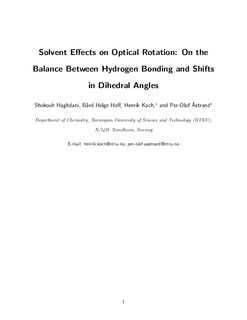| dc.contributor.author | Haghdani, Shokouh | |
| dc.contributor.author | Hoff, Bård Helge | |
| dc.contributor.author | Koch, Henrik | |
| dc.contributor.author | Åstrand, Per-Olof | |
| dc.date.accessioned | 2017-11-09T13:11:55Z | |
| dc.date.available | 2017-11-09T13:11:55Z | |
| dc.date.created | 2017-06-29T14:10:26Z | |
| dc.date.issued | 2017 | |
| dc.identifier.citation | Journal of Physical Chemistry A. 2017, 121 (5), 4765-4777. | nb_NO |
| dc.identifier.issn | 1089-5639 | |
| dc.identifier.uri | http://hdl.handle.net/11250/2465281 | |
| dc.description.abstract | Optical rotations of several conformers of four fluorinated molecules containing the 1-naphthalene or 4-(benzyloxy)phenyl group at the stereocenter have been calculated both in the gas phase and in an aqueous environment. For the compounds containing the 4-(benzyloxy)phenyl group, solvent effects on the optical rotations have also been investigated in chloroform as solvent. Optical rotations have been obtained by time-dependent density functional theory (TDDFT) with the CAM-B3LYP functional and the aug-cc-pVDZ basis set at λ = 589 nm. Implicit and explicit solvent effects were investigated through the polarizable continuum model (PCM) and a microsolvation approach in conjunction with PCM, respectively. In the latter model, solvent molecules are considered as an explicit solvent and their positions are obtained by geometry optimizations for different conformers of the chiral molecule. For molecules containing the 1-naphthalene group, this model gives the same optical rotation signs for all conformers as compared to both gas phase and PCM results and reduces absolute deviations between calculations and experiment. Also, the microsolvation model reproduces the sign of the experimental optical rotations for the molecules containing the 4-(benzyloxy)phenyl group using both water and chloroform as solvent. In a microsolvation model, however, the water and chloroform solvent molecules have similar hydrogen bonds but different effects on the conformation and thereby on the optical rotation since one dihedral angle, having a large effect on the optical rotation, is strongly sensitive to hydrogen bonding to water but not to chloroform. Our investigations demonstrate that a microsolvation approach in conjunction with PCM predicts optical rotations in reasonable agreements with experiments for both sign and magnitude. | nb_NO |
| dc.language.iso | eng | nb_NO |
| dc.publisher | American Chemical Society | nb_NO |
| dc.title | Solvent Effects on Optical Rotation: On the Balance between Hydrogen Bonding and Shifts in Dihedral Angles | nb_NO |
| dc.type | Journal article | nb_NO |
| dc.type | Peer reviewed | nb_NO |
| dc.description.version | acceptedVersion | nb_NO |
| dc.source.pagenumber | 4765-4777 | nb_NO |
| dc.source.volume | 121 | nb_NO |
| dc.source.journal | Journal of Physical Chemistry A | nb_NO |
| dc.source.issue | 5 | nb_NO |
| dc.identifier.doi | 10.1021/acs.jpca.6b12149 | |
| dc.identifier.cristin | 1479906 | |
| dc.relation.project | Notur/NorStore: nn2920k | nb_NO |
| dc.description.localcode | Copyright © 2017 American Chemical Society. This is the authors' accepted and refereed manuscript to the article. Locked until May 31, 2018 due to copyright restrictions | nb_NO |
| cristin.unitcode | 194,66,25,0 | |
| cristin.unitname | Institutt for kjemi | |
| cristin.ispublished | true | |
| cristin.fulltext | postprint | |
| cristin.qualitycode | 2 | |
